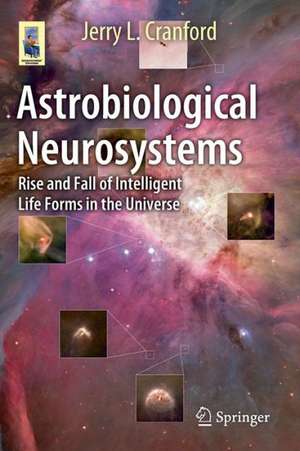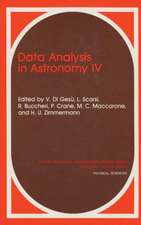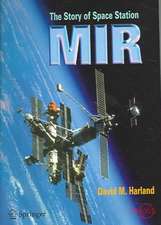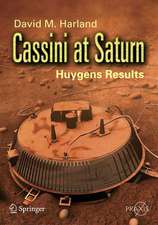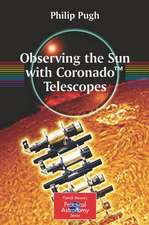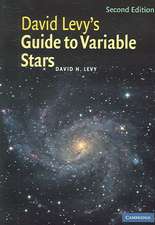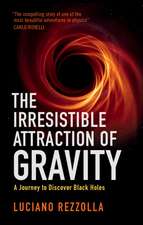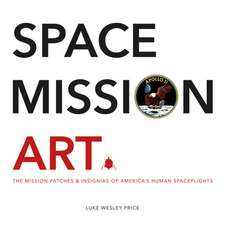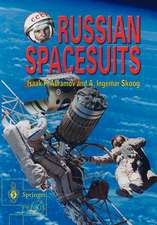Astrobiological Neurosystems: Rise and Fall of Intelligent Life Forms in the Universe: Astronomers' Universe
Autor Jerry L. Cranforden Limba Engleză Paperback – 10 oct 2014
The core of the book explains (and presents educated guesses) how nervous systems evolved on Earth, how they work, and how they might work on other worlds. Combining his knowledge of neuroscience, computers, and astrobiology the author jumps into the discussion whether biological nervous systems are just the first step in the rise of intelligence in the Universe.
The book ends with a description from both the psychologist’s and the neuroscientist’s viewpoints, exactly what it is about the fields of astrobiology and astronomy that “boggles the minds” of many amateur astronomers and interested non-scientists.
This book stands out from other popular science books on astrobiology by making the point that “astro-neurobiologists” need to begin thinking about how alien nervous systems might work.
Din seria Astronomers' Universe
-
 Preț: 210.44 lei
Preț: 210.44 lei -
 Preț: 195.53 lei
Preț: 195.53 lei -
 Preț: 254.90 lei
Preț: 254.90 lei -
 Preț: 284.56 lei
Preț: 284.56 lei -
 Preț: 212.88 lei
Preț: 212.88 lei -
 Preț: 256.41 lei
Preț: 256.41 lei -
 Preț: 264.35 lei
Preț: 264.35 lei -
 Preț: 259.08 lei
Preț: 259.08 lei -
 Preț: 227.61 lei
Preț: 227.61 lei -
 Preț: 277.98 lei
Preț: 277.98 lei -
 Preț: 305.70 lei
Preț: 305.70 lei -
 Preț: 253.11 lei
Preț: 253.11 lei -
 Preț: 216.60 lei
Preț: 216.60 lei -
 Preț: 272.24 lei
Preț: 272.24 lei -
 Preț: 330.75 lei
Preț: 330.75 lei -
 Preț: 179.00 lei
Preț: 179.00 lei -
 Preț: 289.83 lei
Preț: 289.83 lei -
 Preț: 160.03 lei
Preț: 160.03 lei -
 Preț: 200.80 lei
Preț: 200.80 lei -
 Preț: 255.97 lei
Preț: 255.97 lei -
 Preț: 242.58 lei
Preț: 242.58 lei -
 Preț: 262.55 lei
Preț: 262.55 lei -
 Preț: 282.38 lei
Preț: 282.38 lei -
 Preț: 187.82 lei
Preț: 187.82 lei -
 Preț: 225.19 lei
Preț: 225.19 lei -
 Preț: 207.64 lei
Preț: 207.64 lei -
 Preț: 104.35 lei
Preț: 104.35 lei -
 Preț: 188.94 lei
Preț: 188.94 lei -
 Preț: 270.50 lei
Preț: 270.50 lei -
 Preț: 212.01 lei
Preț: 212.01 lei -
 Preț: 169.08 lei
Preț: 169.08 lei -
 Preț: 210.01 lei
Preț: 210.01 lei -
 Preț: 208.26 lei
Preț: 208.26 lei -
 Preț: 253.98 lei
Preț: 253.98 lei -
 Preț: 180.12 lei
Preț: 180.12 lei -
 Preț: 280.19 lei
Preț: 280.19 lei -
 Preț: 273.13 lei
Preț: 273.13 lei -
 Preț: 207.39 lei
Preț: 207.39 lei -
 Preț: 208.70 lei
Preț: 208.70 lei -
 Preț: 214.86 lei
Preț: 214.86 lei -
 Preț: 188.94 lei
Preț: 188.94 lei -
 Preț: 194.65 lei
Preț: 194.65 lei -
 Preț: 277.34 lei
Preț: 277.34 lei -
 Preț: 187.15 lei
Preț: 187.15 lei -
 Preț: 210.93 lei
Preț: 210.93 lei -
 Preț: 212.01 lei
Preț: 212.01 lei
Preț: 207.15 lei
Nou
Puncte Express: 311
Preț estimativ în valută:
39.65€ • 43.08$ • 33.33£
39.65€ • 43.08$ • 33.33£
Carte disponibilă
Livrare economică 31 martie-14 aprilie
Preluare comenzi: 021 569.72.76
Specificații
ISBN-13: 9783319104188
ISBN-10: 3319104187
Pagini: 240
Ilustrații: IX, 204 p. 87 illus., 68 illus. in color.
Dimensiuni: 155 x 235 x 20 mm
Greutate: 0.31 kg
Ediția:2015
Editura: Springer International Publishing
Colecția Springer
Seria Astronomers' Universe
Locul publicării:Cham, Switzerland
ISBN-10: 3319104187
Pagini: 240
Ilustrații: IX, 204 p. 87 illus., 68 illus. in color.
Dimensiuni: 155 x 235 x 20 mm
Greutate: 0.31 kg
Ediția:2015
Editura: Springer International Publishing
Colecția Springer
Seria Astronomers' Universe
Locul publicării:Cham, Switzerland
Public țintă
Popular/generalCuprins
Preface.- Scientists believe intelligent life may be more common in the universe than previously considered possible.- When will mankind achieve “First Contact” with extraterrestrial life forms.- If our nervous system is not the only one that exists in the universe, where are the others and how do we identify them?- Evolution of intelligent nervous systems on other worlds in the universe.- Are biological nervous systems just the first step in the rise of intelligence in the universe?.- Just how hostile is our universe to the development and survival of Life Forms?.- Some Final Thoughts from this “amateur” astronomer on mankind’s imminent discovery that we are not alone in the Universe.- References and further suggested readings.- Index.
Recenzii
“The quintessence of this book is whether there possibly exist brains (central nervous systems) on other planets that might work the same or entirely differently from those found on Earth. … For astro-neurobiological educated guesses, surmises, and ideas, this book is the first of its kind and offers a good read.” (P. Chapman-Rietschi, The Observatory, April, 2016)
“The illustrations are excellent, and there is an extensive bibliography. Most of the subjects are covered in many other books, but the discussion of neurosystems is original and insightful. Summing Up: Recommended. General readers, lower- and upper-division undergraduates.” (T. Barker, Choice, Vol. 52 (12), August, 2015)
“The illustrations are excellent, and there is an extensive bibliography. Most of the subjects are covered in many other books, but the discussion of neurosystems is original and insightful. Summing Up: Recommended. General readers, lower- and upper-division undergraduates.” (T. Barker, Choice, Vol. 52 (12), August, 2015)
Notă biografică
Jerry L. Cranford, Ph.D, CCC-A, is a retired professor at the Department of Communication Disorders at Louisiana State University Health Sciences Center, New Orleans. He is an experienced neuroscientist/psychologist with an extensive background as a funded brain research scientist, and also a lifelong dedicated amateur astronomer whose primary interest is in the question of how intelligent forms of life might develop on other worlds in the universe. Dr. Cranford is attempting to combine his professional knowledge of the brain sciences with his knowledge of astrobiology to speculate on how alien life forms may develop neurobiological control systems that could be functionally analogous to those found in various animal species on Earth. He has extensive experience in writing articles and books for interested non-scientists and strives at making the scientific information he presents as accurate as possible but with a minimum of highly technical jargon.
Textul de pe ultima copertă
This book explains why scientists believe that life may be more common in the Universe than previously considered possible. It presents the tools and strategies astronomers and astrobiologists are using in their formal search for habitable exoplanets as well as more advanced forms of life in other parts of our galaxy. The author then summarizes what is currently known about how and where organic molecules critical to our form of carbon-based life are manufactured.
The core of the book explains (and presents educated guesses) how nervous systems evolved on Earth, how they work, and how they might work on other worlds. Combining his knowledge of neuroscience, computers, and astrobiology the author jumps into the discussion whether biological nervous systems are just the first step in the rise of intelligence in the Universe.
The book ends with a description from both the psychologist’s and the neuroscientist’s viewpoints, exactly what it is about the fields of astrobiology and astronomy that “boggles the minds” of many amateur astronomers and interested non-scientists.
This book stands out from other popular science books on astrobiology by making the point that “astro-neurobiologists” need to begin thinking about how alien nervous systems might work.
The core of the book explains (and presents educated guesses) how nervous systems evolved on Earth, how they work, and how they might work on other worlds. Combining his knowledge of neuroscience, computers, and astrobiology the author jumps into the discussion whether biological nervous systems are just the first step in the rise of intelligence in the Universe.
The book ends with a description from both the psychologist’s and the neuroscientist’s viewpoints, exactly what it is about the fields of astrobiology and astronomy that “boggles the minds” of many amateur astronomers and interested non-scientists.
This book stands out from other popular science books on astrobiology by making the point that “astro-neurobiologists” need to begin thinking about how alien nervous systems might work.
Caracteristici
Written by an experienced brain research scientist, popular science author and lifelong dedicated amateur astronomer Offers scientifically funded speculation on how alien life forms may develop neurobiological control systems that could be functionally analogous to those found in various animal species on Earth Conveys the author's excitement in non-technical language about how things happen in our complex world and universe Includes supplementary material: sn.pub/extras
